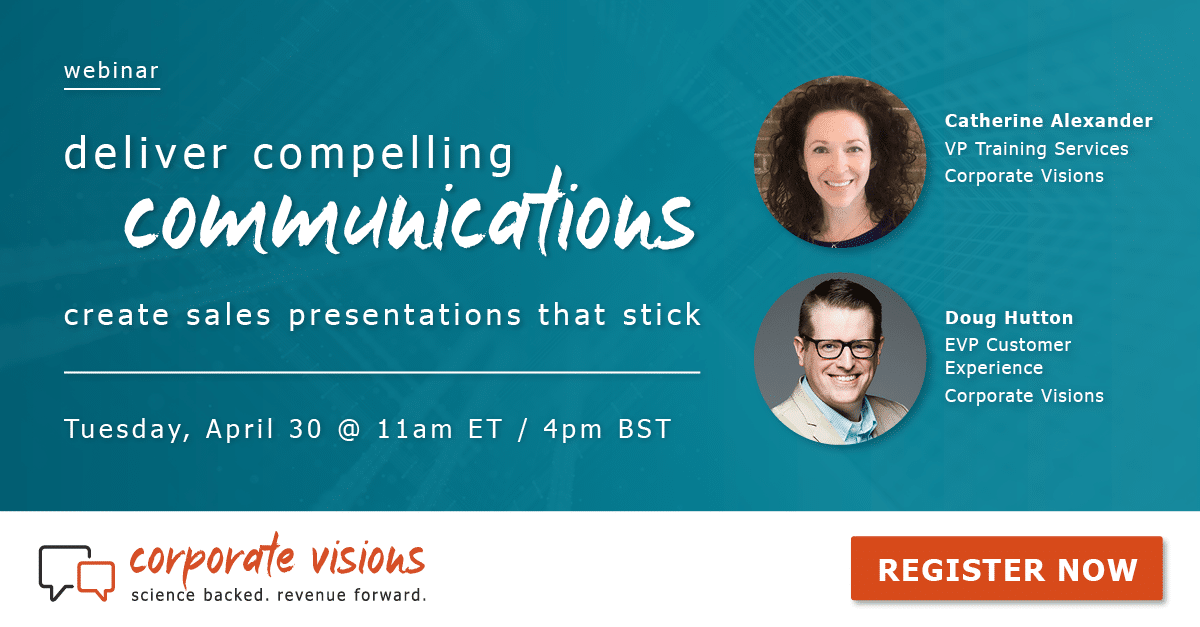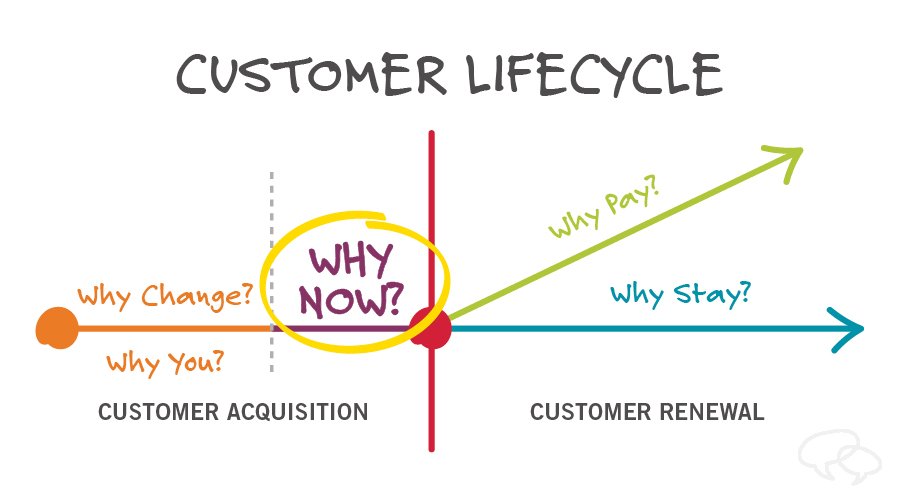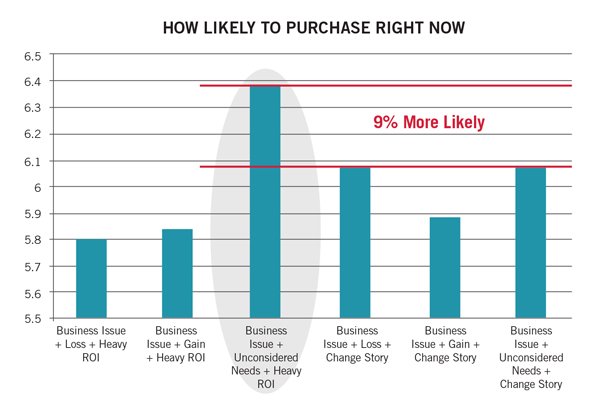Last year, I helped design a Corporate Visions study that dispelled a big, longstanding myth about executive buyers—which is that they’re strictly analytical or numbers-oriented in their decision-making.
Not so.
In fact, the study revealed that executives are no less susceptible to the appropriate emotionally framed message than anyone else—particularly if that message is framed in terms of what buyers stand to lose by not making a business change instead of what they stand to gain by following through with one.
Specifically, the study found that executives are more than 70 percent more willing to make a risky business decision—such as making a change from their current situation—if you frame their status quo in terms of what they might lose versus what they might gain. In both the loss and gain frame test conditions, the math was equivalent. The words themselves—the story, the messaging—were the only things that differed.
(Read about that research in full here.)
“Why Now?”
That study was a textbook case of loss aversion in action. Loss aversion, along with risk-seeking, is a principle important to Prospect Theory, an idea developed by social psychologists Daniel Kahneman and Amos Tversky which holds that humans are two-to-three times more likely to make a decision to avoid a loss than to make a decision to achieve a gain.
The research clued us into the fact that these principles matter when it comes to having effective conversations with executive and financial decision-makers. It also got us wondering: Why do some business proposals stall out instead of gain momentum and buy-in? What actually creates the urgency to get executive buyers to decide instead of defer?
These questions are the basis for our follow-up study, just completed, which addresses the “Why Now” moment in the customer conversation—when salespeople (and marketers!) need to be able to create a business proposal that creates urgency and passes muster with executive and financial buyers.
Here’s how we set that study up.
Researching the “Why Now” Moment
For this research, Corporate Visions contracted with Dr. Nick Lee, a professor of marketing at Warwick Business School in Coventry, U.K.
We designed the test conditions and questions to assess several areas critical to this “moment of truth” in the buyer’s journey—areas including confidence in the business proposal, how urgent it was, how essential to future growth, and to what extent it made executives in the study more or less likely to purchase right now.
The study, conducted online, included 312 executive participants, all of whom are employed at companies with $100 million or more in revenues, and all of whom have budget and decision-making responsibilities.
We then asked all participants to imagine they were part of the following business scenario:
You are an executive at a food processing company that cleans, sorts and packages vegetables. You have traditionally served large vegetable products using large-scale equipment that can process several tons of vegetables per hour. However, the most promising growth market is organic and specialty food production, and unfortunately, you do not have equipment suitable for the small batch requirements of this “small-producer” market.
You will be meeting with a company that makes smaller-scale, more flexible equipment that could help you enter this new market, and they present the following story as to why you should buy their equipment.
We then split the executive participants into six different groups, each of which experienced a different messaging test condition, or pitch, that contained different elements of the following:
- Business Issue: External factors and business initiatives
- Loss: Details about your loss to be avoided
- Gain: Details about your potential positive gain
- Unconsidered Needs: Introduces an unsuspected threat
- Heavy ROI: Hard numbers with a detailed ROI breakdown
- Change Story: Business change story with a light ROI component
We then asked all participants the following set of questions about the message condition they experienced, to which they were then asked to assign a numerical rating, between one nine, based on how impactful they believed the message was in each area.
- How confident are you that this is a good business decision?
- How convincing was the business case as far as getting you to make a decision soon rather than later?
- How important is the solution for future success and growth?
- How urgent is the need to purchase?
- How likely are you to purchase right now?
Results of the Why You, Why Now Sales Study
The most effective message across each of the areas we assessed was structured around presenting a business issue and an unconsidered need before providing a heavy ROI justification. It was the only message condition to finish first in each category. Interestingly, the other message conditions proved to be highly volatile in terms of how they performed in these key areas. In other words, what might have been second or third “best” in one area was dead last in another.
Additionally, the winning condition appears to provide the biggest edge in the two most important areas for the purposes of this study: 1) importance to future success and growth, for which it provides a four percent edge; and 2) likelihood of making a purchase decision right now, for which companies stand to gain a nine percent advantage.

In a post-study analysis, Dr. Lee wrote that the findings of this study are “presented using effect size as the criteria for whether the effect is interesting or not, following the latest opinion in psychological research methods.” He added that a consistent pattern of a “large number of small effects” means that, taken together, “there is a clear argument that [the winning message condition] is more likely to be effective than the others,” and that the unconsidered needs and heavy ROI message “is the way to go” when you’re trying to create urgency and demonstrate business impact in your proposals.
The effectiveness of the message structured around a business issue, an unconsidered need, and a heavy ROI case is consistent with the body of decision-making science research that inspired the study—as well as with our “executive emotions” research. The middle portion of the message—the unconsidered need—can be seen as an extreme form of loss aversion, because it positions their current approach as a loss to be avoided.
This satisfies the emotional, decision-making part of the brain, or what Daniel Kahneman refers to as “System 1” in his book “Thinking Fast and Slow”. Meanwhile, the documented ROI component is consistent with Kahneman’s “System 2,” or neocortex, which supports decision-making. System 2 provides the rationalization and justification of decisions, but does not actually make decisions.
We made a video reviewing this study on our YouTube channel. Click here to view it in a new tab.
To learn more about the research and see an example of the winning “Why Now” framework, check out our State of the Conversation Report.







